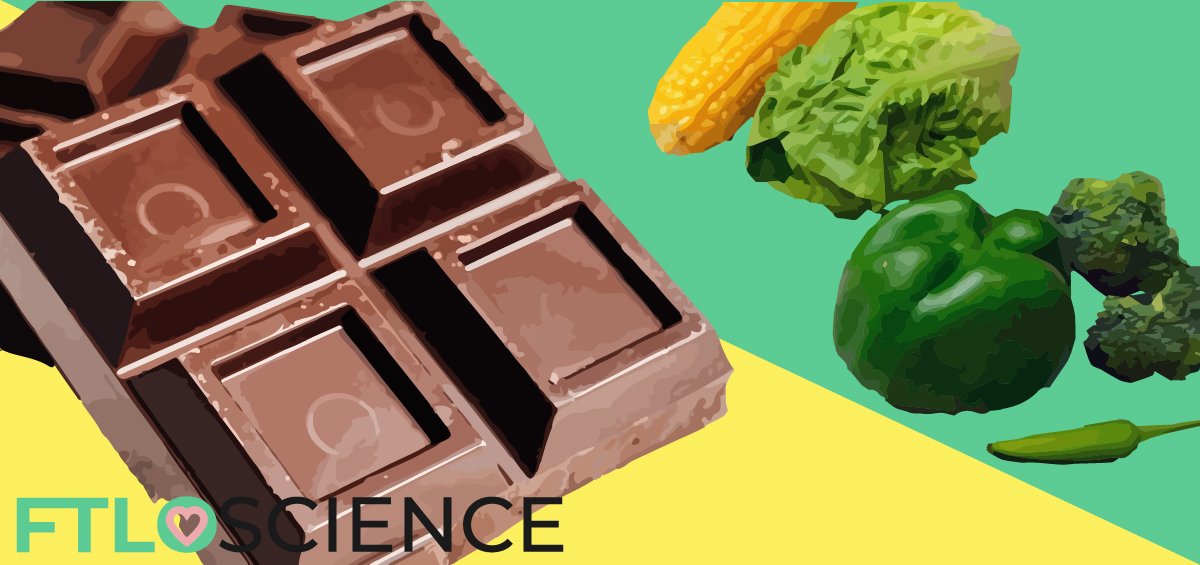Throughout our evolutionary history, our ancestors faced numerous challenges that impeded their survival, such as hostile climates and potential predators. In terms of food, they also faced two distinct types of dangers. On one hand, food is essential to sustain basic functions, providing energy for running away from predators and finding suitable mates to reproduce with. On the other, indiscriminate feeding increases the risk of ingesting toxins, which can be harmful or even lethal. In order to survive and thrive in the wild, evolution has bestowed upon us a taste system for quickly evaluating our food. This article will briefly describe how our innate love for sweet foods and hatred for bitter ones shaped our strategy of food acquisition and ultimately, ensured our survival.
Sweet, Sweet Energy
While food is easily accessible in modern society, earlier hominids spent a substantially large amount of time searching for food and eating. As such, choosing foods with high energy and nutrient content was especially important for survival. Glucose is arguably the most important source of energy. For example, the human brain, which carries out a large repertoire of mental functions, takes up 20% of the body’s total energy expenditure and relies primarily on glucose as its energy source1.
It is therefore unsurprising that humans and many other species have an innate preference for sweetness, as it is indicative of our love for glucose sources such as fructose and glucose in ripe fruits, lactose in milk, sucrose in table sugar and maltose in starch2,3. Since these small molecular weight carbohydrates can be converted easily into glucose, a preference for sweetness would encourage selective intake of these food sources and prevent us from energy depletion. A ‘sweet tooth’ adaptation hence greatly improves our chances of survival.
However, not everything in nature is good to eat. Many toxins commonly found in the wild are harmful to humans, preventing us from feeding indiscriminately. Lucky for us, millions of years of evolution have created safeguards that allow us to distinguish between good and bad food—before it even enters our digestive system!
Taste Receptors for Bitter and Sweet
T1R for Sweetness
How exactly do we detect tiny carbohydrate molecules? The answer lies in specialized proteins known as taste receptors found in our taste buds. Simple sugars can bind strongly to different sites of the sweet taste receptor complex, a heterodimer consisting of T1R (taste receptor type 1) subunits2. Binding in this manner triggers the receptors to send ‘sweet’ signals to our brain, which in turn fires up neurotransmitters that give us feelings of pleasure and satisfaction. Artificial sweeteners work in this manner to transmit the same signals of pleasure, albeit without the calories!
Interestingly, researchers found that the genes coding for T1R is remarkably conserved (or consistent) across species, with the exception of exclusively carnivorous mammals and most birds4. This means that for animals that rely on carbohydrates for energy, the same sweet taste receptors are present and facilitate the selective intake of sugars.
Even more interestingly, while most birds do not have sweet taste receptors (because they feed on seeds and insects), the hummingbird is an exception4. Hummingbirds are the smallest of birds and have a nectar-based diet. As nectar consists of varying amounts of glucose, fructose and sucrose, this further illustrates how the gustatory system evolves differently in response to different dietary requirements and highlights the conserved role of sweet taste receptors in facilitating sugar intake.
T2R for All Kinds of Bitterness
While sugar-sensing T1Rs are highly conserved between species, T2Rs (taste receptor type 2) are much more diverse5. This variation allows us to respond to a whole range of different bitter-tasting compounds, such as ricin, progoitrin and cyanide. It just so happens that many bitter-tasting compounds are harmful to the human body. For instance, ricin causes aggregation of red blood cells while cyanide disrupts ATP production6. Because bitterness in foods has a positive correlation with toxicity, it is believed that the bitter taste perception helped our ancestors avoid ingesting toxic food.
Of course, our hatred for bitter food must have developed alongside the ability to detect bitterness. Indeed, even infants have an innate aversion towards bitter stimuli, further supporting the claim that the bitter taste receptor plays a role in toxin avoidance2,6. Thus, the evolution of bitter taste perception and its associated aversion go hand in hand to reduce the chances of us ingesting toxic food. Plants and vegetables tend to release bitter mustard oils when cut or chewed as a defensive mechanism, which deters potential predators (such as us) from eating them.
Due to the fact that there are many different types of toxins that exist in the natural environment, there is also a large diversity of T2R receptors, and different species may express different T2Rs to detect toxins unique to their habitat. In addition, within the same species, there are also variations. It has been noted that while humans, in general, express 25 functional T2Rs, there are individual differences in sensitivity5. Individuals who are extremely sensitive to bitterness are known as ‘supertasters‘, and they are found in the highest frequency in regions that originally possessed more toxic plants, potentially so that they could deal with the large number of toxins in their environment7.

Evolution of Receptor Diversity
All in all, we can see that as the need for high-energy carbohydrates is more universal, sweet taste receptors are highly conserved across species. In contrast, the types of toxins to be avoided are much more abundant and are unique to different environments, hence the diversity of bitter taste receptors. Taken together, the differential evolution of the perception of sweet and bitter tastes and their associated preference or aversion is extremely crucial for dealing with the distinct challenges of food acquisition and avoidance.
As witnessed in the panda’s diet and specific individuals’ love for spicy food, taste receptors continue to play a significant role in evolutionary biology. We’ve even developed the preference for cooking to improve the nutrition and safety of articles we choose to ingest. As our environment changes, who knows what kind of food will tickle our taste buds in the future?
This article was written by Chen Ruilin via Write For Us.
Reference
- Mergenthaler, P., Lindauer, U., Dienel, G. A., & Meisel, A. (2014). Sugar for the brain: the role of glucose in physiological and pathological brain function. Trends in Neurosciences, 36(10), 587–597. https://doi.org/10.1016/j.tins.2013.07.001
- Beauchamp, G. K. (2016). Why do we like sweet taste: A bitter tale? Physiology & Behavior, 164, 432–437. https://doi.org/10.1016/j.physbeh.2016.05.007
- Breslin, P. A. S. (2013). An Evolutionary Perspective on Food and Human Taste. Current Biology, 23(9), R409–R418. https://doi.org/10.1016/j.cub.2013.04.010
- Baldwin, M. W., Toda, Y., Nakagita, T., Connell, M. J. O., Klasing, K. C., Misaka, T., Edwards, S. V, & Liberles, S. D. (2014). Evolution of sweet taste perception in hummingbirds by transformation of the ancestral umami receptor. 345(6199), 929–934.
- Fischer, A., Gilad, Y., Man, O., & Pa, S. (2004). Evolution of Bitter Taste Receptors in Humans and Apes. 22(3). https://doi.org/10.1093/molbev/msi027
- Reed, D. R. (2010). Genetics of Taste and Smell: Poisons and Pleasures. Progress in Molecular Biology and Translational Science Genes and Obesity, 94, 213-240. https://doi.org/10.1016/B978-0-12-375003-7.00008-X
- Bruner, R. (2014). The Evolution of Bitter Taste | EvolutionShorts. Retrieved 1 October 2020, from https://scholarblogs.emory.edu/evolutionshorts/2014/05/01/the-evolution-of-bitter-taste/
About the Author

This article was written by a contributor. For a full list of guest writers, click here.




